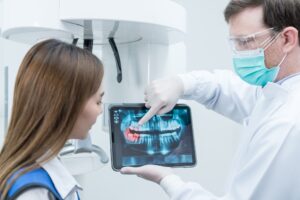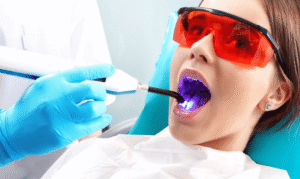Intraoral scanners are changing the face of dental care, making treatments more efficient, accurate, and comfortable for both dentists and patients. These technologies allow specialists to take highly detailed 3D images of a patient’s teeth and gums in real time. Unlike traditional impressions, which involve messy and often unpleasant ones, intraoral scanners use digital technology to produce images quickly and accurately. This digital data can then be used to create crowns, bridges, aligners, and other dental products with greater precision and in less time.
Intraoral Scanner Technology
An intraoral scanner is a handheld device that projects light into a patient’s mouth and uses sensors to create digital images of the teeth and soft tissues. The scanner generates a three-dimensional model of the mouth almost instantly, allowing the dentist to view the digital impression on a screen in real time. The dentist can directly transfer this electronically stored information to a dental lab or design software. The accuracy of these scans eliminates many of the problems associated with traditional molds, such as distortion, air bubbles, and part impressions.
Improve Patient Comfort and Experience
One of the greatest benefits of an intraoral scanner is the comfort it provides the patient. Traditional impression methods typically involve placing a spoon filled with a putty-like substance in the patient’s mouth, which can cause gagging or pain. Intraoral scanners eliminate this unpleasant experience by gently moving a small device around in the mouth without causing irritation. This feature makes the procedure easier, especially for patients with a strong gag reflex, children, or patients who are anxious about dental treatment.
Improve Accuracy and Reduce Human Error
The accuracy of intraoral scanners significantly reduces the chance of errors when performing dental restorations. Because digital impressions are so accurate, crowns, veneers, and aligners fit better. Conventional molds often result in poorly fitting appliances due to shrinkage, movement during installation, or operator error. The margin of error with digital scanning is much smaller. The result is better treatment outcomes, fewer adjustments, and ultimately more satisfied patients.
Reduce Wait Times and Speed up Treatment
Another important benefit of intraoral scanners is time savings. Because the images are captured and stored digitally, dentists can quickly review them and even create a restoration or treatment plan right away. You don’t have to wait for molds or models. In some cases, repairs can be performed the same day, which minimizes the number of office visits for the patient. This shortened approach not only saves the patient time but also improves the overall workflow in the dental office.
Improve Patient Communication
Intraoral scanners can also help dentists and patients communicate more effectively. During the consultation, 3D images can be projected onto a screen, allowing patients to better view their dental problems and better understand the proposed treatment options. This visual aid allows patients to make more informed decisions about their treatment and builds trust between them and the dental staff. When patients can see the problem themselves, they are more likely to receive the necessary treatment and follow recommendations.
Applications of Intraoral Scanning
Intraoral scanners are used in many areas of dentistry, including general, cosmetic, and orthodontic treatments. In restorative dentistry, they help ensure the precision of crowns, bridges, onlays, and dentures. They play an important role in planning veneers and smile makeovers. Orthodontists use intraoral scanning to create clear aligners and track their progress over time. Because the scans are digital, they can be easily stored and compared with previous data. This feature allows you to track changes in dental health and long-term treatment outcomes.
The Future of Intraoral Scanning and Innovation
As technology advances, intraoral scanners are expected to become increasingly sophisticated. The integration of speed, resolution, and artificial intelligence will improve scanning efficiency and accessibility. Some new scanners already use artificial intelligence to automatically detect cavities, assess gum recession, and provide treatment options. These developments will enable more accurate diagnoses and treatment plans. Intraoral scanning combined with other digital technologies, such as 3D printers and machine learning, will redefine the possibilities of modern dentistry and drive the development of personalized and efficient care.
Conclusion
Intraoral scanners are revolutionizing dental care. They offer a more accurate, comfortable, and efficient alternative to traditional impression-taking procedures. They improve the patient experience, treatment outcomes, and the growing digital infrastructure of dentistry. These devices significantly transform the dental industry by cutting down on appointment times, facilitating same-day repairs, and enhancing communication. As technology advances, intraoral scanners will play an increasingly important role in the modern dental practice. They offer clear benefits to patients and dentists, and their implementation represents a significant step forward in oral care.
FAQs
1. What is an intraoral scanner?
An intraoral scanner is a portable digital device that allows dentists to take detailed 3D images of a patient’s teeth and gums without the use of traditional impression materials.
2. Is an intraoral scan painful or uncomfortable?
Intraoral scanning is quick and painless. This method uses a small device to gently scan the inside of your mouth. It is more comfortable than impression trays.
3. Are intraoral scans as accurate as traditional models?
Yes, intraoral scans are often more accurate than traditional models because they eliminate defects such as distortion, air bubbles, and movement that are common during impression taking.
4. How long does an intraoral scan take?
Most intraoral scans take just a few minutes, depending on the area being scanned and the complexity of the case.
5. Can intraoral scanning be used for any type of dental treatment?
Intraoral scanners are widely used in various branches of dentistry, including restorative, cosmetic, and orthodontic care. However, in some situations, additional imaging or diagnostic equipment may be necessary.




